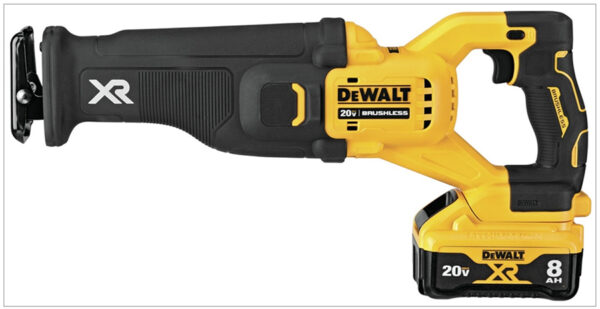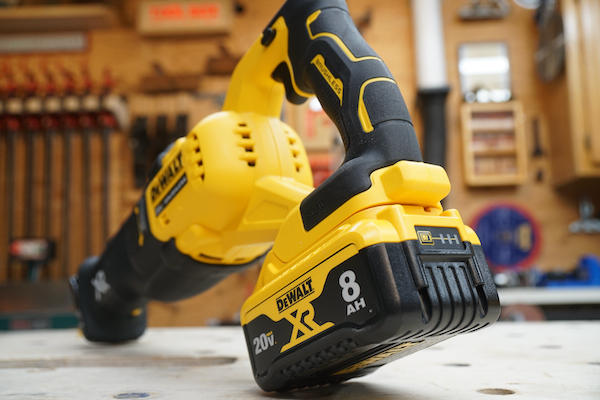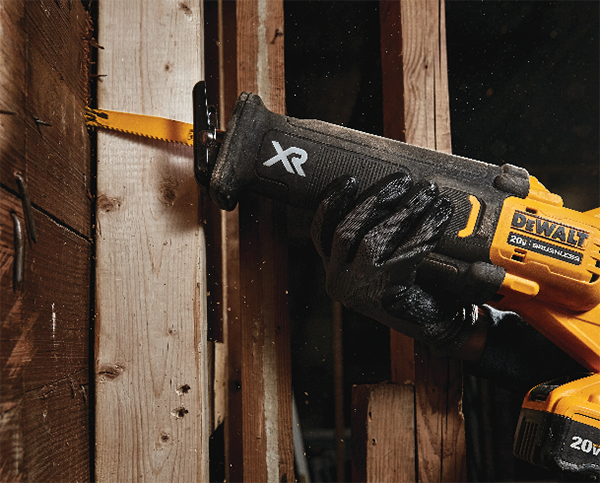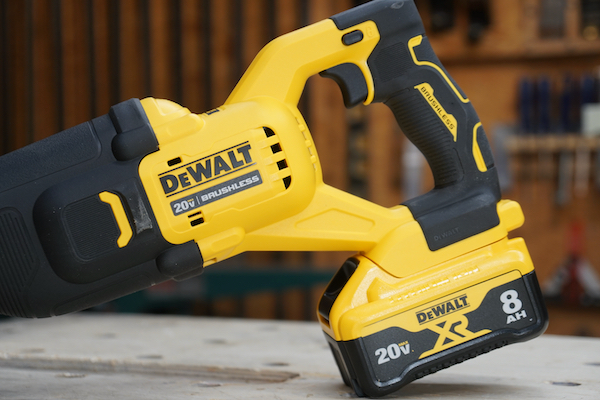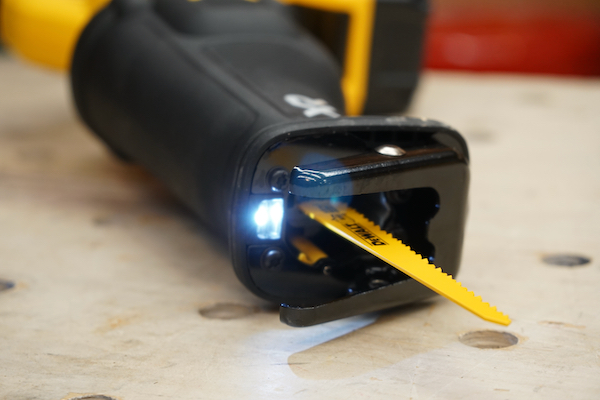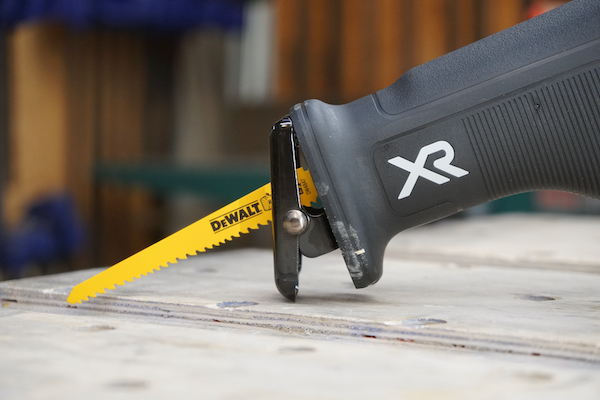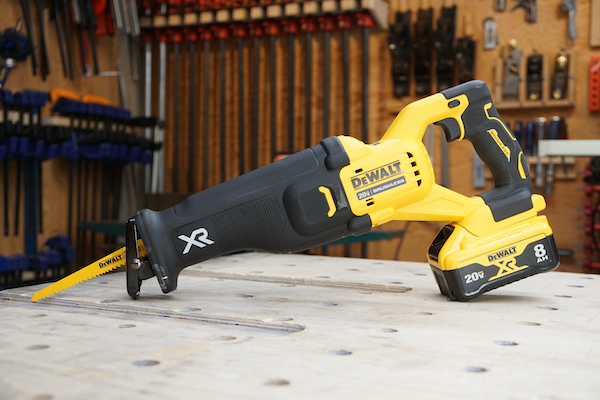DEWALT XR Reciprocating Saw DCS368 Review
DEWALT XR Reciprocating Saw
DEWALT XR Reciprocating Saw DCS368
I usually run a Milwaukee 2721 reciprocating saw. If you follow the Head to Head testing on Toolboxbuzz.com, you may recall that this saw performed quite well in the Head to Head published in December of 2017. The Milwaukee 2721 bested a field of X cordless saws we tested at that time. So this cordless saw is a beast and was the leader of the pack at that time. I figured that it would be a good comparison saw against which to compare the DEWALT DCS368 XR.
Packing 44% more power than its predecessor, this DEWALT reciprocating saw is a substantial upgrade from previous DEWALT models. But how would it compare to the Milwaukee 2721?
Using the DEWALT DCS368 XR
The DEWALT DCS368 XR was very well balanced with a really smooth action. When we plunged the saw into work materials, we felt there was very little kickback. It had plenty of power to cut through a 10 x 10 old-growth oak and it did not bind at all. Additionally, it was able to plunge smoothly into a sill plate we recently replaced. The main reason for this smooth action is due to the new Power DetectTM battery technology. During this fieldwork, we operated the DSC368 saw with an 8 Ah 20v battery and a 10-inch bi-metal DEWALT blade.
DEWALT Power Detect™
DEWALT recently released 4 new tools that operate on the new Power Detect™ battery technology. Power DetectTM battery technology recognizes the type of battery that is installed in the tool and adjusts the tool’s output to the battery in use. All tools with the Power DetectTM technology are currently shipping as kits with the 8.0 amp-hr battery.
21700 Lithium-Ion Batteries
DEWALT is taking advantage of the benefits from going with the 21700 lithium-ion battery technology and coupling it with brushless motor technology and more efficient bus designs, and, yes, the Power Detect™ tools are compatible with the regular 20v batteries, but the performance will be about the same as the DEWALT XR tools.
Power Detect Tools Are FlexVolt Compatible
The Power Detect™ tools can also run the Flex Volt batteries. The tools will benefit from the power boost with the FlexVolt batteries. One thing users may notice is that the 8.0 amp-hr battery that came with their new tool is the same size as a 6.0 Amp-Hr Flex Volt one. I imagine that most users will select the same-sized larger power capacity and run the 8.0 amp-hr battery pack.
DEWALT DCS368 XR Reciprocating Saw Features
- Power DetectTM battery technology
- Keyless lever-action blade clamp
- 1 -⅛ stroke length
- Variable speed trigger
- Brushless motor
- LED work light
- Strokes per minute 0-3000 strokes per minute (SPM)
- Tool weight 8 lbs
- Stroke length 1-⅛ in
- Variable Speed
DEWALT Reciprocating Saw Vs. Milwaukee Sawzall
I recently made a number of cuts in several 4” EMT conduits. I thought this would be a good opportunity to see how the DEWALT saw stacked up against the one I have been using for the past 30 months. Since I wanted to have a fair comparison, I set up a weighted pulley system to apply the downward force during the cut. My pulley system has an 11-pound weight that hangs down from a ceiling-mounted pulley. The paracord wraps around another floor-mounted pulley and is attached directly to the tool.
In this way, I held the tool horizontal and the weight of 11 pounds pulls the tool into the workpiece. This type of pulley system is the only way I can ensure that the comparison between the two tools is a level playing field.
Test Results
Both saws were outfitted with similar-sized batteries – 8.0 Amp-hr for the DEWALT saw and 9.0 Amp-hr for the Milwaukee. Since the test was going to be fairly short in duration, I thought the extra 1.0 Amp-hr would make no difference.
In addition, I had two new Diablo carbide blades. These new blades are specifically designed to cut thin wall conduits. In this way, I could be sure that the cutting blades contributed equally to the way the comparison was run. The only variable left in the test was the relative power and blade speed difference between the DEWALT DCS368 saw and the Milwaukee 2721 saw.
I used a video camera in slow motion mode to time the start of the blade moving and the time that the cut went through the conduit material. Using this slow-motion technique gave me the ability to review the film of each cut and know, with great accuracy, the duration for each cut I made.
I ran the cut test three times for each saw. At the end, I compiled the results and tabulated the results, below.

I felt the power of the DEWALT DCS368 XR the moment I started to cut the 4” EMT conduit. It chewed through the thin wall metallic tubing with little problem. The DSC368 is a simple tool and it is easy to use.
It was only after making all of the cuts that I knew the new DEWALT Power Detect™ was going to measure up well in this comparison. As you can see in the table and graph, the DEWALT saw was within 2.0% of the identical performance to the Milwaukee saw. The new battery technology and the other changes have made a substantial difference.
In the previous TBB test using similar test techniques, the DEWALT entrant took 38% longer than the top-rated Milwaukee saw in a similar type of conduit cutting test. Since that Head to Head, DEWALT closed the performance gap to only 2.0% difference in my comparison. That is a remarkable improvement.
It is all in the math
When comparing reciprocal saws, users can figure out the Total Stroke Length per Minute to get a sense of how saws might compare against each other. Typically, manufacturers publish the stroke length and Stroke speed of their saws. If the user multiplies these two numbers together, then it creates the Total Stroke Length per minute metric. This number should give an insight into how well the saws stack up to each other. In this case, I calculated the DEWALT DCS368 XR to have a Total Stroke Length per Minute of 3,375.
This figure is identical to the metric produced by the Milwaukee saw. No wonder these saws produce nearly identical performance numbers. One caution, however, is that this Stroke Speed is for a saw that is not under load and the multiplication produces a result that is under no-load conditions. So it is not an absolute comparison indicator.
Using the DEWALT DCS368 XR
It almost doesn’t matter what trade you’re in, you probably own a reciprocating saw. The reciprocating saw is my go-to tool for remodeling, special cuts, and demolition projects.
Dewalt is no stranger to “user experience,” and “user experience design.” On its simplest level, user experience is how the user feels about every interaction you have with the tool in front of you.
Dewalt hit the user experience mark with the DSC368 saw. We immediately liked the look, feel, and size of this saw. Its compact and lightweight design was evident from first use until I later zipped it up in the tool bag.
Compact Size
The compact size of the DEWALT DCS368 XR allows it to better fit between stud and joist bays as well as confined spaces. The tool weighs 5 lbs., [without battery], and measures 14.5” in length.
The shape and design makes the saw smaller and more compact, than traditional reciprocating saws, as well as allowed us more control and balance.
Blade Stroke
The DEWALT DCS368 XR gives the user a 1-1/8″ stroke length. The variable speed trigger allows this reciprocating saw to deliver from a stopped condition the full speed range up to 3,000 strokes per minute.
Blade Changing
The DEWALT DCS368 XR features a lever-action, 2-position, blade clamp for quick and easy blade changes in two directions for a variety of applications including flush cutting. At the end with the blade changing lever, a bright single LED light illuminates the blade area.
Rubberized Anti-Slip Grip
The DSC368 has a rubberized anti-slip grip [rubber boot] which helps increase safety around the front end of the tool to help absorb vibration and reduce hand fatigue.
At the other end of the saw, the tool’s trigger handle is amazingly comfortable. In fact, it may well be the best-fitting and comfortable tool handle among the manufacturers I have used. DEWALT really hit the mark with their handle design on the DSC368.
DEWALT DCS368 XR Improvements
There are two things on the DSC368 that I think need attention. Firstly, I’d like to see the addition of a rafter hook on this tool. While I may not always use one, The times when I am on a high-lift, I would like to hook this tool on the top rail, not set it onto the floor where I am sure to either kick it or trip over it.
Second, I think the lack of a shoe that adjusts outward from the nose of the saw is a real oversight. This feature, present on many other saws, allows me to get additional life out of a worn blade while also allowing me to have the shoe to press up against the material I’m cutting. With the current configuration of the DSC368, if a blade wears out next to the shoe, the user must replace the blade, even though there may be several inches of the blade that is still used.
What’s Included in the DEWALT DCS368 XR Kit
- DCS367 20V Brushless XR Compact Reciprocating Saw
- DCB205 XR Li-Ion Battery (5.0 Ah)
- DCB115 Charger
- (1) Kit Bag
Cost
The DEWALT DCS368 XR With Power Detect™ Kit includes (1) saw, (1) battery charger, (1) 20v MAX Lithium-Ion 8.0 Ah battery, and (1) kit bag.
I found the DSC368 online as a kit for a price of $279.00 and $199.00 as a bare tool at Ohop Power Tools.
dewalt DEWALT XR Reciprocating Saw DCS368
Buy Now From Our Sponsored Retailers
Also Available From
This tool comes with the DEWALT 3 year limited tool warranty, 1-year free service and, a 90-day money-back guarantee.
Final Thoughts On The DSC368 Saw
Overall, the DEWALT 20 Volt XR Reciprocating Saw With Power Detect™ is a powerful, well-balanced, and ergonomically comfortable tool. DEWALT has done an admirable job of increasing the tool performance with their Power Detect™ technology and other improvements. Clearly, the performance we saw, should warrant folks to give strong consideration to adding this reciprocating saw to their tool inventory
The DSC368 is a basic but full-featured saw. I only wish it had a rafter hook and an outwardly adjustable shoe. With those, this saw would be close to becoming a leader in its category. As it is, I give this saw 4.7 stars out of 5.
About the author
Disclosure
Product reviews on this site contain our opinion of a product or service. We will always strive for objectivity and transparency in our reviews. Our goal is to provide readers with honest, objective information based on our own experiences. We never have and never will accept payment in exchange for a positive review. Many of the products that we review are provided to us for free by a manufacturer or retailer. In some cases, we also have advertising or affiliate relationships with manufacturers and retailers of products and services we review. For additional information please visit our additional disclosure policies.











